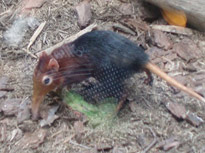Scandentia -- Surreptitiously shrewd treeshrews



Origins
The word Scandentia comes from the word scando, meaning "to climb" or "climber". This order is found all across the Asian subcontinent and even in the archipelagos of Indonesia and the Phillipines. Of course, like other Asian fauna, they are also not found on the Australian side of the Wallace Line. These animals have some similarities with primates like us but their ancestors and ours diverged too far back in the mists of time for us to embrace each other like long lost cousins. The fossil record is embarassingly slim to be the basis of any serious relationship.
Our common naming conventions call them shrews when they are decidedly not so. Also not all 20 species in this order live up in the trees or are necessarily great climbers. Let's just say we are quite confused about these pretty creatures and just call them shrews for the sake of convenience.
What are they like?
Tree shrews look very much like squirrels ( they are in fact called Tupai, stands for squirrel in Malay). They are slender animals with long tails and soft, greyish to reddish-brown fur. Those species that live on the ground tend to be larger than those that live in the trees, and to have larger claws, which they use for digging up insect prey.
Treeshrews have good vision, which is binocular in the case of the more tree-dwelling species. Most are are active in the morning and evening, although the Pen-tailed Treeshrew is nocturnal (parties at night). These animals live in small family groups, which defend their territory from intruders. They mark their territories using various scent glands, or urine, depending on the particular species.
Another interesting aspect to these cute little animals is that they have a higher brain to body mass ratio than even humans. Does that mean they are smater than us? No, it just means that they have bigger brains in proportion to us. I have seen snails that are smarter than some people and they have no brains. Brain size is so 20th century, anyway.
Geographic Distribution
View Larger Map
Tree shrews are found everywhere this side of the Himalayas and are extensively found in Indonesia, Malaysia and the Phillipines.
Reproduction
Female treeshrews give birth to up to three young after a gestation period of 45 to 50 days, in nests lined with dry leaves inside tree hollows. The young are born blind and hairless, but are able to leave the nest after about a month. During this period, the mother provides relatively little maternal care, visiting her young only for a few minutes every other day to suckle them. Apparently, tough love is the way among tree shrews.
Feeding Habits
Treeshrews are opportunistic feeders. So they will eat insects, eggs, fruit and seeds, basically whatever can fit in their dainty little mouths. In 2008, researchers even found that the Pen-tailed Treeshrew in Malaysia was able to consume large amounts of naturally fermented nectar of up to 3.8% alcohol content the entire year without having any effects on behaviour. Now that is a feeding habit a lot of us humans would love to imitate if we could!
Families within scandentia
Tupaiidae (Treeshrews)
Ptilocercidae (Pen-Tailed Treeshrews)
Videos